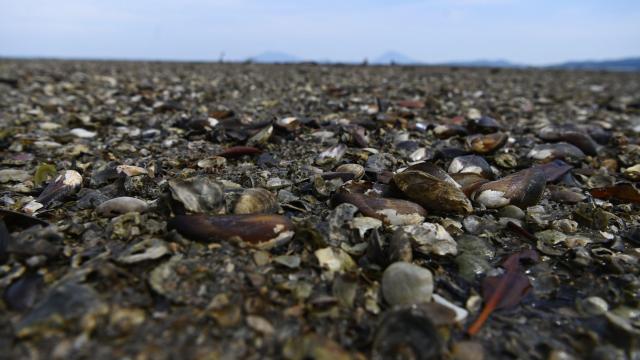There’s bad news for crustacean lovers. Some researchers are estimating that more than 1 billion sea creatures — including clams, mussels, barnacles, and snails — basically cooked to death during the record Pacific Northwest heat wave.
Chris Harley, a marine biologist at the University of British Columbia, told the CBC that he was “pretty stunned” walking along Vancouver’s Kitsilano Beach late last month, where was able to smell the mass death and see endless amounts of mussels cracked open with meat inside — which indicates they had recently died.
The incredibly hot temperatures in Vancouver and some poor timing with the tides seem to have combined to create an incredibly sad situation for the region’s crustaceans. During the heatwave in late June, when temperatures reached 40 degrees Celsius in Vancouver, Harley’s lab recorded temperatures up to 122 degrees F (50 degrees Celsius) along the shoreline using a thermal imaging camera. Crustaceans like mussels and clams were then exposed to these crazy high temperatures for more than six hours when the tide went out.
“A mussel on the shore in some ways is like a toddler left in a car on a hot day,” Harley told the CBC. “They are stuck there until the parent comes back, or in this case, the tide comes back in, and there’s very little they can do. They’re at the mercy of the environment. And on Saturday, Sunday, Monday, during the heat wave, it just got so hot that the mussels, there was nothing they could do.”
He and students in his lab said they are working on gathering evidence to calculate how many sea creatures died in the Salish Sea, an inland sea encompassing the waters off Vancouver and Seattle, during last week’s heat wave, but he estimates that the number is at least 1 billion, based on some back-of-the-napkin maths he did while walking the beach.
“If you’re losing a few hundred or a few thousand mussels for every major shoreline, that quickly scales up to a very, very large number,” he said.
The large number brings to mind the widespread suffering seen in Australia during the bushfires of 2019-20, when an estimated 3 billion animals perished or were otherwise impacted. But more tragically, it’s also a data point in the widespread damage happening to the ocean as the climate continues to warm. Harley said that while the populations along the coast should rebound in a year or two, more intense and recurring heat waves could eventually damage crustacean populations.
That’s bad news for the creatures that serve both as food for mussels and clams, like plankton, as well as larger animals that feed on crustaceans. Ocean acidification, another impact of climate change, has also been a huge problem on the West Coast and has taken a toll on mussels and other shell-forming creatures.
“Eventually, we just won’t be able to sustain these populations of filter feeders on the shoreline to be anywhere near the extent that we’re used to,” Harley told the CBC.
The impacts of climate change are hardly limited to crustaceans or the Pacific Northwest alone. Sea stars have died off in droves in recent years due to a wasting disease that’s become more common years of extreme ocean heat. And just this past month, the United Nations warned that the Great Barrier Reef is “in danger” due to rapidly warming waters.
It’s not just Harley who noticed nature’s grisly clam bake last week. Hama Hama Oyster Company, a shellfish farm sitting on a fjord of the Salish Sea on Washington’s Olympic Peninsula, documented dozens of cracked-open, seemingly cooked clams dotting an expanse of mud.
“We’ve been worried about climate change for a long time,” Lissa James Monberg, Marketing Director of her family’s Hama Hama Company, told our friends at The Takeout. “I want people to know that it’s not something abstract happening to people far away. It’s not someone else’s problem. It’s our problem. This is our food supply.”
